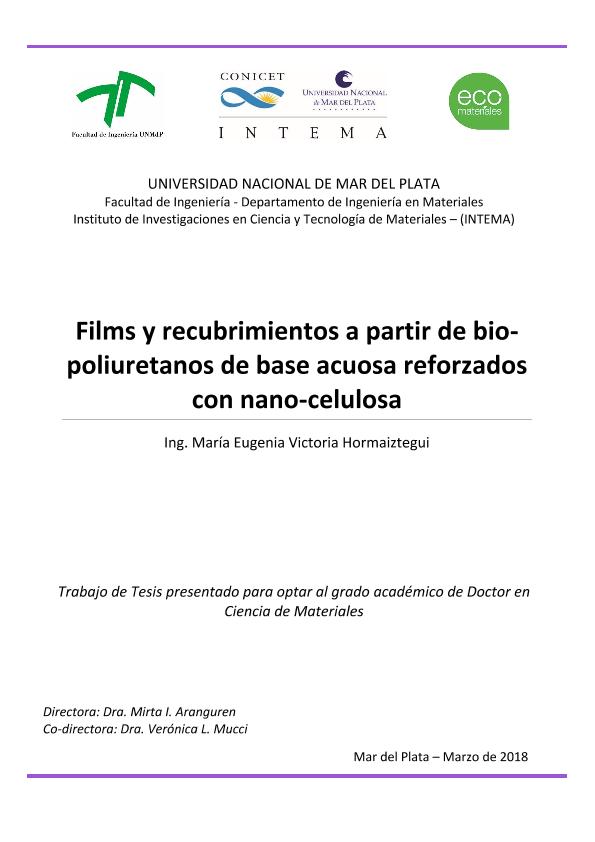Mostrar el registro sencillo del ítem
dc.contributor
Aranguren, Mirta Ines

dc.contributor
Mucci, Veronica Lujan

dc.contributor.author
Hormaiztegui, Maria Eugenia Victoria

dc.date.available
2019-12-10T14:54:30Z
dc.date.issued
2018-03-26
dc.identifier.citation
Hormaiztegui, Maria Eugenia Victoria; Aranguren, Mirta Ines; Mucci, Veronica Lujan; Films y recubrimientos a partir de biopoliuretanos de base acuosa reforzados con nano-celulosa; 26-3-2018
dc.identifier.uri
http://hdl.handle.net/11336/91840
dc.description.abstract
En las últimas décadas el mundo ha sido testigo de un creciente interés del público, las instituciones académicas y el sector industrial por aprovechar mejor los recursos renovables y reducir el impacto negativo de la actividad humana en el medio ambiente. El uso de productos bio-derivados permite reducir la huella de CO2 en los materiales desechados, y en muchos casos mejorar la biodegradabilidad de materiales poliméricos, cuya contraparte basada en el petróleo es generalmente reconocida por su persistencia en el ambiente. Por esta razón, se ha renovado la investigación de productos derivados de la biomasa, desarrollándose desde combustibles hasta novedosos materiales que se incorporan en productos finales de alto volumen y/o alto valor agregado como los dedicados a la industriaautomotriz y de envases.Los poliuretanos (PUs) son materiales poliméricos versátiles, con una amplia variedad de propiedades físicas y químicas. Gran parte de estos PUs generan emisiones de compuestos orgánicos volátiles (VOCs) a la atmósfera durante su aplicación, por lo que los esfuerzos de los investigadores no se han restringido sólo a las etapas de síntesis y producción sino que también se han enfocado en la reducción de la generación de los VOCs.En ese marco se inserta este trabajo de tesis, cuyo objetivo es la obtención de una matriz de poliuretano de base acuosa (WBPU por sus siglas en inglés: waterborne polyurethane) utilizando como bio-precursores un aceite vegetal y un ácido carboxílico, afectando entonces tanto la formulación como la reducción en la generación de VOCs. Con el objetivo de obtener mejoras en las propiedades mecánicas, térmicas y tribológicas de estos poliuretanos se propone la utilización de nanocristales de celulosa (CNC), celulosa bacterial o celulosa microfiblilar como bio-refuerzo de las diferentes matrices poliméricas obtenidas durante el desarrollo de la presente tesis.
dc.description.abstract
In this thesis work, reinforced polymeric materials containing high bio-carbon and low VOC contents were synthesized and characterized. To achieve this goal, waterborne biopolyurethanes were prepared and further reinforced with micro/nano cellulose, which is also obtained from the biomass. A brief summary of the Chapters’ contents is included below. In Chapter 1 a brief introduction to the selected topic and the state of the art is presented, as well as the motivation for the study and the goals of this research work. The raw materials, experimental techniques and methods used in the synthesis and characterization of the different materials are presented in Chapter 2. Chapter 3 is dedicated to the discussion of the properties of the different celluloses used as reinforcement of the polymeric matrices. In particular, in this study, cellulose nanocrystals were obtained from the acid hydrolysis of microcrystalline cellulose. The other biogenic reinforcements were introduced in our work thanks to the collaboration with another research group of the Ecomaterials Division, INTEMA (bacterial cellulose) and to the collaboration with the “Materials + Technologies” Group, University of the Basque Country (microfibrillar cellulose, MFC). It is important to stress that the main goal in this thesis work was to achieve the synthesis of bio-based polyurethanes with good compatibility with the selected micro/nanoreinforcements. For this reason, polymeric materials were prepared based on two diols, a synthetic one (polycaprolactone diol, PCL) and another one based on castor oil (CO1). Later on, a vegetable oil: unmodified castor oil, was used as polyol for the synthesis of the PUs, thus, increasing the percentage of biobased raw materials used in the synthesis of the WBPUs. The last replacement of a synthetic reactant by a biobased one consisted in the replacement of dimethyl propionic acid (DMPA) by tartaric acid (TA). The acid component provides the ionic centers that allow the dispersion of the PU in water by formation of a salt with added triethylamine (TEA). (Chapter 4) In Chapter 5, the incorporation of the different celluloses in (o into) the polymeric matrices is discussed. A first section presents the effect of the addition of microfibrillar cellulose in PU matrices obtained from diols with different molecular structure. Then, a discussion is presented of the comparative effects of bacterial cellulose and cellulose nanocrystals (CNC) added to a WBPU synthesized from unmodified castor oil. A third section presents an analysis of the effect of the incorporation of CNC on matrices obtained from castor oil and additionally with the use of the tartaric acid. Then, in Chapter 6, the results of preliminary studies are presented that are focused on the potential application of the prepared WBPU as coatings. The performance of these preparations was analyzed from the results of macro and microscopic tests. Finally, Chapter 7 presents the general conclusions of the work and proposes several studies to continue the research on this subject in the future.
dc.format
application/pdf
dc.language.iso
spa
dc.rights
info:eu-repo/semantics/embargoedAccess
dc.rights.uri
https://creativecommons.org/licenses/by-nc-sa/2.5/ar/
dc.subject
Nanocristales de celulosa
dc.subject
Aceite de ricino
dc.subject
Poliuretanos
dc.subject
Materiales compuestos
dc.subject.classification
Compuestos

dc.subject.classification
Ingeniería de los Materiales

dc.subject.classification
INGENIERÍAS Y TECNOLOGÍAS

dc.title
Films y recubrimientos a partir de biopoliuretanos de base acuosa reforzados con nano-celulosa
dc.type
info:eu-repo/semantics/doctoralThesis
dc.type
info:eu-repo/semantics/publishedVersion
dc.type
info:ar-repo/semantics/tesis doctoral
dc.date.updated
2019-10-24T20:01:42Z
dc.description.fil
Fil: Hormaiztegui, Maria Eugenia Victoria. Consejo Nacional de Investigaciones Científicas y Técnicas. Centro Científico Tecnológico Conicet - Mar del Plata. Instituto de Investigaciones en Ciencia y Tecnología de Materiales. Universidad Nacional de Mar del Plata. Facultad de Ingeniería. Instituto de Investigaciones en Ciencia y Tecnología de Materiales; Argentina
dc.rights.embargoDate
2020-06-10
dc.conicet.grado
Universitario de posgrado/doctorado

dc.conicet.titulo
Doctor en Ciencia de Materiales
dc.conicet.rol
Autor

dc.conicet.rol
Director

dc.conicet.rol
Codirector

dc.conicet.otorgante
Consejo Nacional de Investigaciones Científicas y Técnicas. Centro Científico Tecnológico Conicet - Mar del Plata. Instituto de Investigaciones en Ciencia y Tecnología de Materiales. Universidad Nacional de Mar del Plata. Facultad de Ingeniería. Instituto de Investigaciones en Ciencia y Tecnología de Materiales

Archivos asociados
